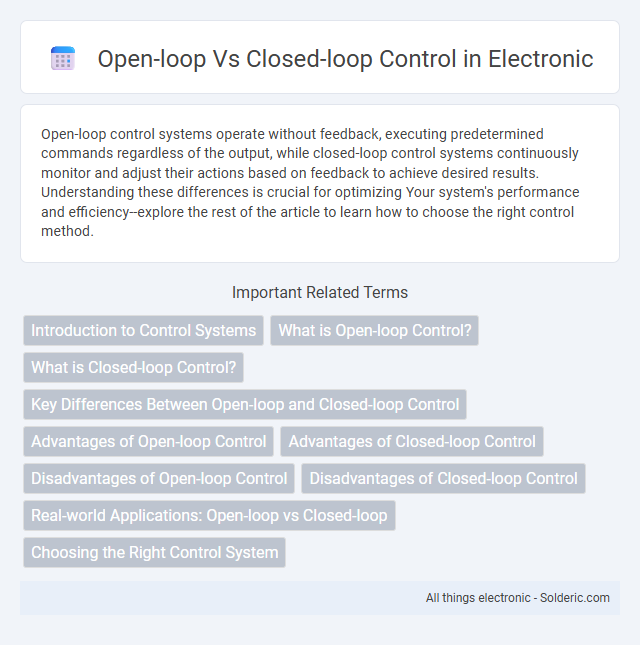Open-loop control systems operate without feedback, executing predetermined commands regardless of the output, while closed-loop control systems continuously monitor and adjust their actions based on feedback to achieve desired results. Understanding these differences is crucial for optimizing Your system's performance and efficiency--explore the rest of the article to learn how to choose the right control method.
Comparison Table
| Feature | Open-Loop Control | Closed-Loop Control |
|---|---|---|
| Definition | Control action independent of output feedback | Control action depends on output feedback |
| Feedback | No feedback used | Uses feedback for correction |
| Accuracy | Less accurate, prone to errors | High accuracy through correction |
| Complexity | Simple design and implementation | More complex due to feedback components |
| Cost | Lower cost | Higher cost due to sensors and controllers |
| Response to Disturbances | Poor, no correction | Good, automatic correction |
| Example | Washing machine without water level sensor | Thermostat-controlled heating system |
Introduction to Control Systems
Open-loop control systems operate without feedback, relying solely on predefined inputs to achieve a desired output, making them simpler but less accurate. Closed-loop control systems use feedback from sensors to continuously adjust and correct the output, improving precision and stability in processes such as temperature regulation or motor speed control. Understanding these differences helps you select the right control strategy for applications demanding either simplicity or dynamic response.
What is Open-loop Control?
Open-loop control is a system where the output is not measured or fed back for correction, relying solely on preset inputs and control actions. This type of control is effective in processes with predictable and consistent environments, such as simple heating or timed lighting systems. Your applications benefit from open-loop control by simplifying design and reducing costs when feedback is unnecessary for accuracy.
What is Closed-loop Control?
Closed-loop control is a dynamic system where feedback from the output is continuously measured and compared to the desired input, enabling automatic adjustments to maintain accuracy. This control method enhances system stability by correcting errors in real time, often using sensors and controllers to optimize performance. Your processes benefit from closed-loop control by achieving higher precision and adaptability in varying operational conditions.
Key Differences Between Open-loop and Closed-loop Control
Open-loop control systems operate without feedback, executing pre-set commands irrespective of the output, leading to potential inaccuracies in dynamic environments. Closed-loop control systems continuously monitor output through feedback sensors, adjusting inputs to maintain desired performance and compensate for disturbances. The primary difference lies in adaptability: open-loop is simpler but less precise, while closed-loop offers higher accuracy and stability through real-time corrections.
Advantages of Open-loop Control
Open-loop control systems offer simplicity and cost-effectiveness by operating without feedback, making them easier to design and maintain. They provide fast response times since no sensor data processing is required, which benefits applications with predictable and stable environments. Their reliability increases due to fewer components, reducing the risk of failures or malfunctions in industrial automation and basic household appliances.
Advantages of Closed-loop Control
Closed-loop control systems provide precise regulation by continuously monitoring output and adjusting inputs to maintain desired performance despite disturbances. This dynamic feedback enhances accuracy, reduces errors, and improves system stability compared to open-loop control. Your processes benefit from increased adaptability and resilience, making closed-loop control ideal for complex and variable environments.
Disadvantages of Open-loop Control
Open-loop control systems suffer from a lack of feedback, which results in poor accuracy and inability to correct errors or disturbances during operation. These systems cannot adapt to changes in the environment or load variations, often leading to inefficient performance and potential system instability. Maintenance and troubleshooting become challenging due to the absence of self-correcting mechanisms inherent in closed-loop control designs.
Disadvantages of Closed-loop Control
Closed-loop control systems can suffer from increased complexity, leading to higher costs and maintenance requirements compared to open-loop systems. They are vulnerable to sensor inaccuracies and delays, which may cause instability or degraded performance. Moreover, closed-loop systems often require more processing power, resulting in slower response times in fast-changing environments.
Real-world Applications: Open-loop vs Closed-loop
Open-loop control systems are commonly used in applications where the process is simple and predictable, such as in household appliances like washing machines and microwave ovens, where the system operates without feedback to adjust actions. Closed-loop control systems dominate complex, dynamic environments like automotive cruise control and industrial robotics, where continuous feedback ensures precise adjustments to maintain the desired output despite disturbances. The choice between open-loop and closed-loop control hinges on factors like system complexity, need for accuracy, and external variability in real-world applications.
Choosing the Right Control System
Selecting the right control system depends on the application requirements, with open-loop control offering simplicity and cost-effectiveness for processes with predictable outcomes and minimal disturbance. Closed-loop control enhances accuracy and stability by using feedback to continuously adjust system performance, making it ideal for dynamic environments requiring precise regulation. Evaluating factors such as system complexity, desired precision, and tolerance to external disturbances ensures optimal control system selection.
Open-loop vs Closed-loop control Infographic

 solderic.com
solderic.com